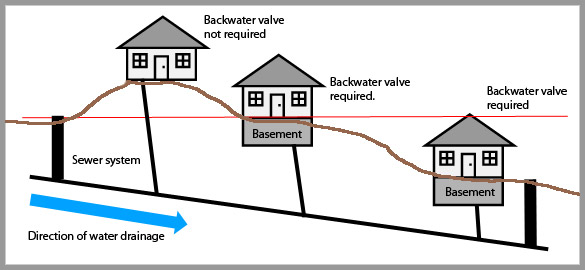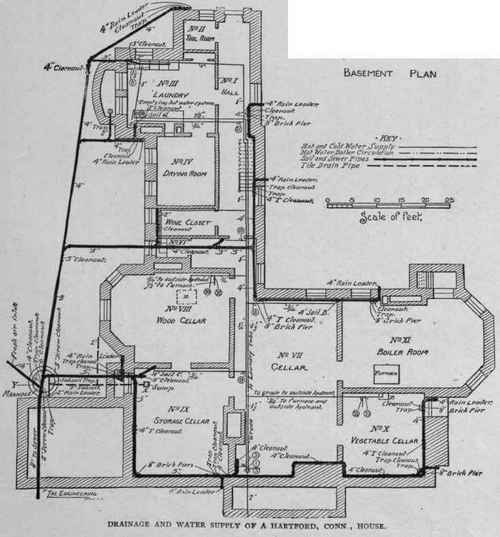The Key Components of Your Property's Plumbing System
The Key Components of Your Property's Plumbing System
Blog Article
We have stumbled upon the article relating to Understanding Your Home's Plumbing Anatomy below on the net and accepted it made good sense to write about it with you here.

Understanding just how your home's plumbing system works is necessary for every home owner. From delivering clean water for alcohol consumption, cooking, and showering to securely eliminating wastewater, a properly maintained plumbing system is crucial for your family's health and wellness and convenience. In this thorough overview, we'll explore the complex network that makes up your home's pipes and deal suggestions on upkeep, upgrades, and handling common problems.
Intro
Your home's plumbing system is greater than just a network of pipes; it's a complicated system that guarantees you have accessibility to tidy water and effective wastewater elimination. Knowing its components and exactly how they interact can help you stop costly repair work and make sure whatever runs efficiently.
Standard Elements of a Pipes System
Pipelines and Tubing
At the heart of your plumbing system are the pipelines and tubing that lug water throughout your home. These can be made from different materials such as copper, PVC, or PEX, each with its advantages in regards to sturdiness and cost-effectiveness.
Components: Sinks, Toilets, Showers, and so on.
Fixtures like sinks, bathrooms, showers, and bath tubs are where water is used in your home. Comprehending exactly how these components attach to the pipes system aids in diagnosing troubles and planning upgrades.
Valves and Shut-off Points
Shutoffs regulate the circulation of water in your pipes system. Shut-off shutoffs are vital during emergencies or when you need to make repair work, enabling you to separate parts of the system without interfering with water circulation to the whole residence.
Water Supply System
Main Water Line
The main water line links your home to the local supply of water or a personal well. It's where water enters your home and is distributed to various components.
Water Meter and Stress Regulatory Authority
The water meter procedures your water use, while a stress regulatory authority makes sure that water moves at a secure stress throughout your home's pipes system, protecting against damages to pipelines and components.
Cold Water vs. Warm water Lines
Recognizing the difference between cold water lines, which supply water straight from the major, and warm water lines, which lug warmed water from the hot water heater, assists in fixing and planning for upgrades.
Drain System
Drain Pipes Piping and Traps
Drain pipes bring wastewater away from sinks, showers, and toilets to the sewer or septic tank. Catches stop drain gases from entering your home and likewise trap debris that can create blockages.
Ventilation Pipes
Ventilation pipelines enable air into the water drainage system, stopping suction that might slow drain and create catches to vacant. Correct ventilation is important for maintaining the integrity of your plumbing system.
Value of Appropriate Drain
Making sure proper drain protects against backups and water damages. Regularly cleansing drains and maintaining traps can prevent pricey fixings and extend the life of your plumbing system.
Water Furnace
Types of Water Heaters
Hot water heater can be tankless or conventional tank-style. Tankless heaters warm water on demand, while containers keep heated water for prompt usage.
Exactly How Water Heaters Connect to the Pipes System
Comprehending exactly how hot water heater link to both the cold water supply and hot water circulation lines aids in identifying issues like inadequate hot water or leakages.
Maintenance Tips for Water Heaters
Routinely purging your water heater to eliminate debris, inspecting the temperature level setups, and examining for leakages can extend its life-span and improve power efficiency.
Typical Pipes Problems
Leakages and Their Causes
Leaks can take place because of aging pipes, loosened installations, or high water stress. Attending to leakages quickly protects against water damages and mold development.
Clogs and Obstructions
Clogs in drains and bathrooms are commonly brought on by flushing non-flushable products or a buildup of grease and hair. Utilizing drainpipe screens and being mindful of what drops your drains pipes can avoid blockages.
Indicators of Plumbing Issues to Expect
Low water stress, slow drains, foul odors, or abnormally high water costs are signs of possible plumbing issues that need to be dealt with immediately.
Pipes Maintenance Tips
Routine Examinations and Checks
Arrange yearly pipes examinations to catch issues early. Search for indications of leaks, deterioration, or mineral accumulation in taps and showerheads.
Do It Yourself Maintenance Tasks
Easy jobs like cleansing faucet aerators, looking for toilet leakages using dye tablets, or insulating exposed pipes in chilly environments can avoid significant plumbing problems.
When to Call a Specialist Plumber
Know when a plumbing problem needs professional know-how. Trying complicated fixings without correct knowledge can lead to even more damages and greater repair service expenses.
Upgrading Your Plumbing System
Reasons for Upgrading
Upgrading to water-efficient fixtures or changing old pipelines can boost water top quality, minimize water expenses, and boost the worth of your home.
Modern Pipes Technologies and Their Benefits
Explore innovations like wise leak detectors, water-saving toilets, and energy-efficient water heaters that can save cash and lower ecological impact.
Expense Factors To Consider and ROI
Determine the upfront prices versus long-lasting financial savings when taking into consideration plumbing upgrades. Lots of upgrades pay for themselves with decreased utility bills and less repairs.
Environmental Influence and Preservation
Water-Saving Fixtures and Home Appliances
Installing low-flow taps, showerheads, and bathrooms can considerably minimize water use without giving up performance.
Tips for Minimizing Water Usage
Straightforward routines like repairing leakages quickly, taking much shorter showers, and running full lots of laundry and dishes can conserve water and reduced your utility expenses.
Eco-Friendly Plumbing Options
Think about lasting plumbing products like bamboo for floor covering, which is durable and environment-friendly, or recycled glass for countertops.
Emergency Readiness
Steps to Take Throughout a Plumbing Emergency situation
Know where your shut-off shutoffs are located and exactly how to switch off the supply of water in case of a ruptured pipe or significant leakage.
Importance of Having Emergency Calls Handy
Maintain call details for regional plumbers or emergency solutions readily available for fast reaction throughout a plumbing dilemma.
DIY Emergency Situation Fixes (When Appropriate).
Short-term solutions like making use of air duct tape to spot a leaking pipeline or placing a pail under a leaking tap can lessen damages till an expert plumbing shows up.
Verdict.
Comprehending the composition of your home's plumbing system empowers you to maintain it effectively, saving money and time on fixings. By following normal maintenance regimens and remaining notified about modern-day plumbing innovations, you can guarantee your plumbing system runs efficiently for many years ahead.
Understanding Your Home Plumbing System: A Comprehensive Guide
Plumbing System: The Lifeline of Your Home
At its core, the plumbing system is designed to perform two primary functions: bring fresh water into your home and remove wastewater. The system is a network of pipes, fixtures, and other components that transport water and sewage. Residential plumbing systems include potable water supply lines, drain-waste-vent (DWV) systems, and various plumbing fixtures that make water use in daily tasks possible.
Key Components:
Water Supply: This part of your plumbing system brings municipal water into your home, passing through the main water supply line. It s responsible for supplying all water needs, from drinking to bathing.
Drainage System: It carries waste and water away from your home to the sewer or septic system. This system includes all the piping within your home that leads to external sewage or septic systems.
Vent System: An essential yet often overlooked component, the vent system allows sewer gases to escape and lets air into the drainpipes, ensuring water and waste move correctly through the system.
Fixture: More Than Just Taps and Toilets
Plumbing fixtures are the most interactive parts of the plumbing system, including faucets, showers, toilets, and sinks. Each fixture is connected to the plumbing system and plays a role in either the delivery of freshwater or the disposal of waste and wastewater.
Types of Fixtures:
Faucets and Sinks: Used for washing hands, dishes, and other daily water needs.
Toilets: Dispose of human waste through the sewage system.
Bathtubs and Showers: Provide bathing facilities, requiring both hot and cold water supply.
Water Supply: The Source of Life
The water supply system is a critical component, ensuring that potable water is available throughout your home for various uses, including drinking, cooking, and cleaning. This system consists of pipes that distribute water to different parts of the house, controlled by valves to regulate the water flow.
Types of Plumbing: Materials and Methods
Various types of plumbing systems and materials are used in residential settings, each with its advantages and applications. From copper and PVC pipes for water supply to cast iron and ABS for drainage, the choice of materials can impact the longevity and efficiency of your plumbing system.
https://intownplumbingtx.com/articles/home-plumbing-system-guide/

Understanding Your Home Plumbing System: A Comprehensive Guide
Plumbing System: The Lifeline of Your Home
At its core, the plumbing system is designed to perform two primary functions: bring fresh water into your home and remove wastewater. The system is a network of pipes, fixtures, and other components that transport water and sewage. Residential plumbing systems include potable water supply lines, drain-waste-vent (DWV) systems, and various plumbing fixtures that make water use in daily tasks possible.
Key Components:
Water Supply: This part of your plumbing system brings municipal water into your home, passing through the main water supply line. It s responsible for supplying all water needs, from drinking to bathing.
Drainage System: It carries waste and water away from your home to the sewer or septic system. This system includes all the piping within your home that leads to external sewage or septic systems.
Vent System: An essential yet often overlooked component, the vent system allows sewer gases to escape and lets air into the drainpipes, ensuring water and waste move correctly through the system.
Fixture: More Than Just Taps and Toilets
Plumbing fixtures are the most interactive parts of the plumbing system, including faucets, showers, toilets, and sinks. Each fixture is connected to the plumbing system and plays a role in either the delivery of freshwater or the disposal of waste and wastewater.
Types of Fixtures:
Water Supply: The Source of Life
The water supply system is a critical component, ensuring that potable water is available throughout your home for various uses, including drinking, cooking, and cleaning. This system consists of pipes that distribute water to different parts of the house, controlled by valves to regulate the water flow.
Types of Plumbing: Materials and Methods
Various types of plumbing systems and materials are used in residential settings, each with its advantages and applications. From copper and PVC pipes for water supply to cast iron and ABS for drainage, the choice of materials can impact the longevity and efficiency of your plumbing system.
https://intownplumbingtx.com/articles/home-plumbing-system-guide/
Do you appreciate reading up on Understanding Your Home's Plumbing Anatomy? Try leaving feedback down below. We would be glad to find out your reactions about this entry. We hope to see you back again in the near future. In case you enjoyed reading our blog entry please be sure to share it. We recognize the value of reading our article about Plumbing Installation 101: All You Need to Know.
Click Here Report this page